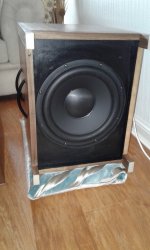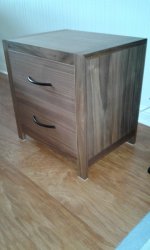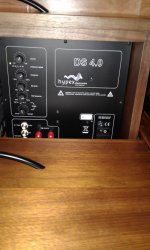So I finished my new sealed sub using a Scan Speak Discovery 30W4558T00 driver and Hypex DS 4.0 plate amplifier.
I bunged the ports on my main speakers with foam so still some breathing going on (its a 2.1 for music) I then took some readings using warble tones and a noise meter and apart from a few db drop at 40 and 32 hz the main speakers were about the same readings as before.
I worked out the -3db point and set the crossover for this all worked out fine.
But here is the weird thing I got the wife to turn the phase knob while I sat in my normal listening place and it seemed that the bass was loudest at 90 deg.
She went out and I fiddled about for a while and then sat in a chair near the plate amplifier which is not on the subwoofer but in my unit with the rest of the equipment near the right speaker and I found that the sound was fuller at 0 deg. the subwoofer is actually near the left speaker about 8 feet from where i was now sitting.
How does that happen.
Another strange thing is that I read that you should play the mains with some pink noise and take the reading and the disconnect the mains and turn up the sub to give the same reading.
I did this but to match the mains the sub gain was at maximum which did not seem right.
Anyway after doing that I played some music with big bass and the bass was massive everything in the room was vibrating including the floor which is solid so I tuned the gain down so that the sub was just supporting the mains and it started to sound a lot better.
So I would say the matching the sub to the mains is not the best thing to do unless you want to end up with a bass only system.
Still dont understand the phase thing though.
I bunged the ports on my main speakers with foam so still some breathing going on (its a 2.1 for music) I then took some readings using warble tones and a noise meter and apart from a few db drop at 40 and 32 hz the main speakers were about the same readings as before.
I worked out the -3db point and set the crossover for this all worked out fine.
But here is the weird thing I got the wife to turn the phase knob while I sat in my normal listening place and it seemed that the bass was loudest at 90 deg.
She went out and I fiddled about for a while and then sat in a chair near the plate amplifier which is not on the subwoofer but in my unit with the rest of the equipment near the right speaker and I found that the sound was fuller at 0 deg. the subwoofer is actually near the left speaker about 8 feet from where i was now sitting.
How does that happen.
Another strange thing is that I read that you should play the mains with some pink noise and take the reading and the disconnect the mains and turn up the sub to give the same reading.
I did this but to match the mains the sub gain was at maximum which did not seem right.
Anyway after doing that I played some music with big bass and the bass was massive everything in the room was vibrating including the floor which is solid so I tuned the gain down so that the sub was just supporting the mains and it started to sound a lot better.
So I would say the matching the sub to the mains is not the best thing to do unless you want to end up with a bass only system.
Still dont understand the phase thing though.
Makes perfect sense to me! 
You want it to sound the best at your listening position, and yes, it will change anywhere you move in the room. Just the nature of the Beast with a subwoofer ...that's why the phase pot is there.
Also are you setting it AT the -3db point? If it were me I would set it at the lowest frequency that is still full output.
And hey ....we want pictures!
You want it to sound the best at your listening position, and yes, it will change anywhere you move in the room. Just the nature of the Beast with a subwoofer ...that's why the phase pot is there.
Also are you setting it AT the -3db point? If it were me I would set it at the lowest frequency that is still full output.
And hey ....we want pictures!
If you measure the in-room response of your speakers and subwoofer, you will see that the amplitude response is far from flat at low frequencies. +- 10 dB is common. It also differs at different locations. A non-flat amplitude response usually also means a non-flat phase response.
Pink noise contains an equal amount of power in each (logarithmically divided) frequency bin. Your main speakers play over a wider bandwidth, so there are more frequency bins, so there is more power, so they will be louder on your SPL meter if the subwoofer is set up correctly. Furthermore, an A weighting filter on the SPL meter will makes things worse, as it partially ignores low frequencies.Another strange thing is that I read that you should play the mains with some pink noise and take the reading and the disconnect the mains and turn up the sub to give the same reading.
I did this but to match the mains the sub gain was at maximum which did not seem right.
Last edited:
A good way is to use the REL setup procedure.
0. Connect the sub with high level outs and run the main speakers full range.
1. Place the sub in a corner, adjacent to one of the speaker. The corner position will give the best room response.
2. Find a sound track with heavy, repetitive bass lines.
3. Turn the xover to its highest frequency, so the speakers and sub overlap
4. Playing bass heavy music, adjust the phase until the bass is the loudest. This is the correct phase setting.
5. Check orientation - turn the sub, so the driver is pointing parallell with the wall behind the speakers. Compare if the sub has the driver pointing along the side wall. Whatever is loudest is correct.
6. Placement. Put the sub all the way into the corner while playing. Gradually move the sub a little out along the diagonal. It may be a few inches out, or up to a foot, but there is a point where the sub will go audibly much lower. This is the correct position.
7. Gain. Turn the xo to its lowest setting and adjust gain until it sounds balanced. This is the correct setting.
8. Xo frequency. Turn up the frequency gradually, until it starts to be audibly too much. Then back down a little.
Johan-Kr
0. Connect the sub with high level outs and run the main speakers full range.
1. Place the sub in a corner, adjacent to one of the speaker. The corner position will give the best room response.
2. Find a sound track with heavy, repetitive bass lines.
3. Turn the xover to its highest frequency, so the speakers and sub overlap
4. Playing bass heavy music, adjust the phase until the bass is the loudest. This is the correct phase setting.
5. Check orientation - turn the sub, so the driver is pointing parallell with the wall behind the speakers. Compare if the sub has the driver pointing along the side wall. Whatever is loudest is correct.
6. Placement. Put the sub all the way into the corner while playing. Gradually move the sub a little out along the diagonal. It may be a few inches out, or up to a foot, but there is a point where the sub will go audibly much lower. This is the correct position.
7. Gain. Turn the xo to its lowest setting and adjust gain until it sounds balanced. This is the correct setting.
8. Xo frequency. Turn up the frequency gradually, until it starts to be audibly too much. Then back down a little.
Johan-Kr
Very helpfull understand now why the difference.Makes perfect sense to me!
You want it to sound the best at your listening position, and yes, it will change anywhere you move in the room. Just the nature of the Beast with a subwoofer ...that's why the phase pot is there.
Also are you setting it AT the -3db point? If it were me I would set it at the lowest frequency that is still full output.
And hey ....we want pictures!
Have set it back to 90 deg so it now sounds best where I actually sit.
No longer have the gain at max. now at one o'clock on the dial. Max. is five o'clock.
Surpring how the bass changes from one CD to another looks like sometimes I will need to trim back the gain a bit and sometimes go up a bit.
Will post some pics later.
Good stuff, I tried this and worked very well.A good way is to use the REL setup procedure.
0. Connect the sub with high level outs and run the main speakers full range.
1. Place the sub in a corner, adjacent to one of the speaker. The corner position will give the best room response.
2. Find a sound track with heavy, repetitive bass lines.
3. Turn the xover to its highest frequency, so the speakers and sub overlap
4. Playing bass heavy music, adjust the phase until the bass is the loudest. This is the correct phase setting.
5. Check orientation - turn the sub, so the driver is pointing parallell with the wall behind the speakers. Compare if the sub has the driver pointing along the side wall. Whatever is loudest is correct.
6. Placement. Put the sub all the way into the corner while playing. Gradually move the sub a little out along the diagonal. It may be a few inches out, or up to a foot, but there is a point where the sub will go audibly much lower. This is the correct position.
7. Gain. Turn the xo to its lowest setting and adjust gain until it sounds balanced. This is the correct setting.
8. Xo frequency. Turn up the frequency gradually, until it starts to be audibly too much. Then back down a little.
Johan-Kr
Only thing is the usual problem that on some CDs there is too much bass and on others it seems not to be there due to poor or old recordings.
If you measure the in-room response of your speakers and subwoofer, you will see that the amplitude response is far from flat at low frequencies. +- 10 dB is common. It also differs at different locations. A non-flat amplitude response usually also means a non-flat phase response.
Pink noise contains an equal amount of power in each (logarithmically divided) frequency bin. Your main speakers play over a wider bandwidth, so there are more frequency bins, so there is more power, so they will be louder on your SPL meter if the subwoofer is set up correctly. Furthermore, an A weighting filter on the SPL meter will makes things worse, as it partially ignores low frequencies.
I suppose one of my problems is that the warble tones I have used from a Stereophile test disc dont show me the room gain on my SPL meter.
My sub is not in a corner but next to my left speaker on a 9metre long wall.
It is a downfire sub and obviously close to the back wall and floor so at 32hz I probably get 6/7db gain which is not measured by the meter.
Standing waves. Wavelengths align with your room dimensions and the pressure focusses in different places. Each place in your room will have different excess peaks and dips in the response.
Some of these will line up with certain parts of music you listen to, ie some music might not excite a peak that you have at your listening position.
It can make it impossible to find the right combination because there isn't one. Your room is in control. Where you place the sub changes the situation but the room will remain in control.
You could combine multiple subs at different locations, which can be very effective but finding the right locations and phase at each frequency takes time.
Some of these will line up with certain parts of music you listen to, ie some music might not excite a peak that you have at your listening position.
It can make it impossible to find the right combination because there isn't one. Your room is in control. Where you place the sub changes the situation but the room will remain in control.
You could combine multiple subs at different locations, which can be very effective but finding the right locations and phase at each frequency takes time.
Even with my limited knowledge compared to a lot of folks around here, if I think I can help, I will. Same goes for learning, if I think I can glean useful knowledge from folks here, I'm 'all ears', so-to-speak. There's a ton of knowledgeable people here, some with boatloads of common sense to boot...Very helpfull understand now why the difference.
Have set it back to 90 deg so it now sounds best where I actually sit.
No longer have the gain at max. now at one o'clock on the dial. Max. is five o'clock.
Surpring how the bass changes from one CD to another looks like sometimes I will need to trim back the gain a bit and sometimes go up a bit.
Will post some pics later.

The differences in bass output between differnt recordings is one of the only drawbacks of owning an accurate, quality sub ....sometimes it drive me nuts! ..lol..
One of these days, or should I say over months, I'm going to re-master some of the older stuff using my studio software. I haven't tested it yet, but something tells me I can do a lot better job than some of the commercial re-masters I have heard over the years...
Oh, and awesome job on the build and finish of your sub, seems as though you have loads of experience in woodworking. Again, great job!

Cheers
-Steve
Thanks for the kind comments about my woodwoorking skills.
I have in fact made many things over the years but must admit I was very pleased with the finished subwoofer box.
The framework is solid timber and the panels veneered MDF, finished with 2 coats of hardwax oil which I think is one of the best ways of finishing timber ever made available.
Timber and veneer are of course American Black Walnut which I love, all my lounge furniture is made from this.
I have in fact made many things over the years but must admit I was very pleased with the finished subwoofer box.
The framework is solid timber and the panels veneered MDF, finished with 2 coats of hardwax oil which I think is one of the best ways of finishing timber ever made available.
Timber and veneer are of course American Black Walnut which I love, all my lounge furniture is made from this.
Well, that's quite another kettle of fish.Good stuff, I tried this and worked very well.
Only thing is the usual problem that on some CDs there is too much bass and on others it seems not to be there due to poor or old recordings.
You can't really blame the sub for records produced with way overdone bass. Nor can you blame the sub for records produced with no bass.
To do anything resembling a fix for those kinda problems, you'll need an amp with tone controls or an equalizer...
Johan-Kr
Well, that's quite another kettle of fish.
You can't really blame the sub for records produced with way overdone bass. Nor can you blame the sub for records produced with no bass.
To do anything resembling a fix for those kinda problems, you'll need an amp with tone controls or an equalizer...
Johan-Kr
Oh no not blaming the subwoofer, just finding it hard to set it just right so that all cds sound just right without keep having to adjust the gain.
Or use an EQ as stated above. That's essentially what I'll be doing when I 're-master' all my music, it's just that the EQ will be 'pre-applied' in my case.
Does you pre/amp have EQ options in it?
No EQ on amplification but the sub bass amp has up to 6db boost from 20 to 50 hz (variable). So I can increase or reduce boost and increase or reduce gain seems to work out the same in practice.
Probably is not but to my ear it is.
- Status
- This old topic is closed. If you want to reopen this topic, contact a moderator using the "Report Post" button.
- Home
- Loudspeakers
- Subwoofers
- Weird


